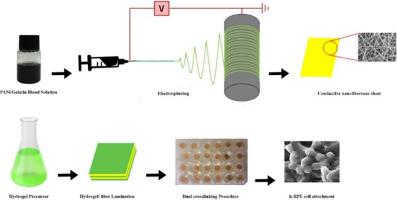Biomaterials Advances ( IF 5.5 ) Pub Date : 2021-05-13 , DOI: 10.1016/j.msec.2021.112180 Maedeh Khodamoradi , Mahnaz Eskandari , Hamid Keshvari , Reza Zarei

|
Many research groups have investigated the various kinds of scaffolds to mimic the natural Bruch's membrane (BM) and support the retinal pigmented epithelial cells to form an organized cellular monolayer. While using prosthetic BM is identified as a promising treatment of age-related macular degeneration (AMD), a degenerative and progressive retinal disease, the effects of different signals such as electrical and morphological cues on the retinal pigmented epithelial (RPE) cells are still unknown. In this study, a laminated and conductive hydrogel/fiber composite scaffold by adding conductive polyaniline (PANi) to the scaffold's nanofibrous phase was prepared. This hybrid scaffold offers the closest morphology to the native structure of the human Bruch's membrane by imitating the inner and outer collagenous layer and induces the electrical signal to the scaffold to assess the electrical cue on behaviors of polarized retinal pigmented epithelial cells in the retina. The electrospun nanofibrous phase consisted of gelatin-Polyaniline in different ratios incorporated into the hydrogel precursor, a blend of gelatin and 4-armed PEG. We used a novel dual crosslinking process by incorporating the exposure of gamma irradiation and glutaraldehyde vapor treatment to construct the scaffold's hydrogel phase. The results showed the best composition was the sample which included the 40/60, Polyaniline/gelatin nanofiber sheets ratio because this scaffold revealed a 2.66 ± 0.33 MPa, Young's modulus and 1.84 ± 0.21 S/cm, electrochemical conductivity, which are close to the main features of native Bruch's membrane. In addition, this scaffold showed good biocompatibility by reaching 83.47% cell viability.
中文翻译:

导电混合支架作为人工布鲁赫膜
许多研究小组已经研究了各种支架,以模仿天然布鲁赫膜(BM)并支持视网膜色素上皮细胞形成有组织的细胞单层。尽管使用人工修复的BM被认为是治疗年龄相关性黄斑变性(AMD)(一种退行性和进行性视网膜疾病)的有前途的治疗方法,但尚不清楚诸如电信号和形态学信号等不同信号对视网膜色素上皮(RPE)细胞的影响。在这项研究中,通过将导电聚苯胺(PANi)添加到支架的纳米纤维相中,制备了一种层压且导电的水凝胶/纤维复合支架。这种混合支架提供了最接近人类Bruch'天然结构的形态 通过模仿内部和外部胶原层形成S膜,并向支架感应电信号,以评估关于视网膜中视网膜色素上皮细胞极化的行为的电信号。电纺纳米纤维相由掺入水凝胶前体中的不同比例的明胶-聚苯胺,明胶和4-臂PEG的混合物组成。我们采用了一种新型的双重交联工艺,将γ射线照射和戊二醛蒸气处理相结合,从而构建了支架的水凝胶相。结果表明,最佳成分是包含40/60,聚苯胺/明胶纳米纤维片比的样品,因为该支架显示出2.66±0.33 MPa,杨氏模量和1.84±0.21 S / cm,电化学电导率,接近于天然布鲁赫膜的主要特征。另外,该支架通过达到83.47%的细胞生存力表现出良好的生物相容性。











































 京公网安备 11010802027423号
京公网安备 11010802027423号